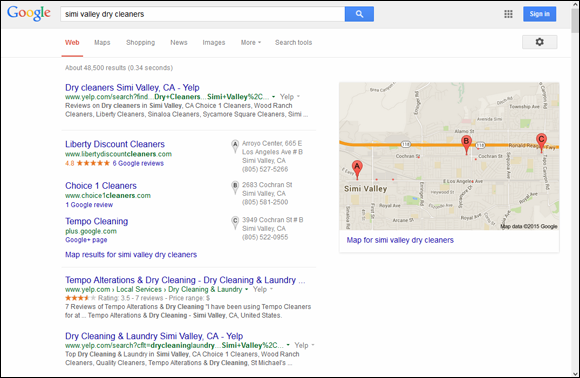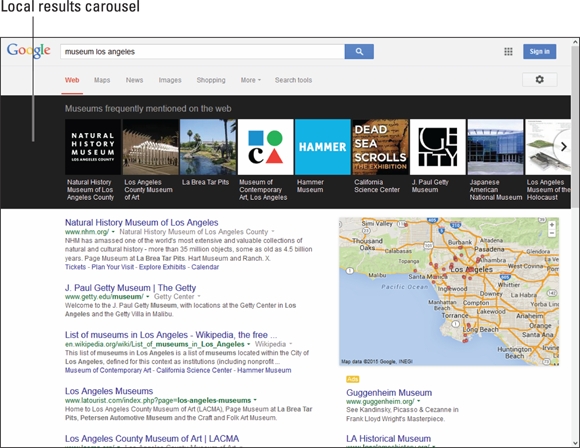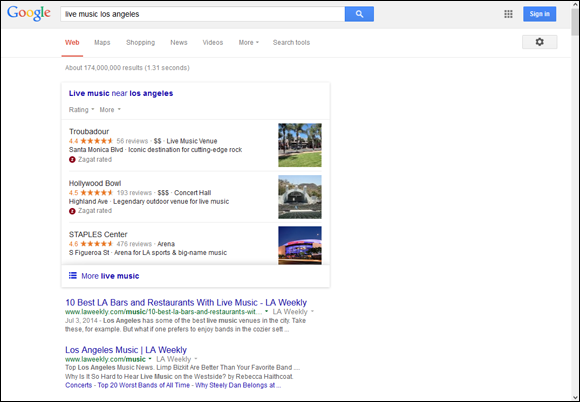Chapter 4
Adapting Your Content for Local Search
In This Chapter
- Exploring the formats of local results
- Maximizing your visibility in organic local results
- Understanding the need for local SEO
- Meeting Google’s Pigeon algorithm
- Optimizing content to be found in local searches
- Creating local landing pages the right way
- Answering common questions for the mobile searcher
Do you have a brick-and-mortar storefront and want to make sure the locals can find you in online searches? Or maybe you have a service business and you serve all the towns and cities within driving distance. Perhaps your business has multiple locations around the region or country, or maybe just a national headquarters. Regardless, you still want to show up in location-based searches and compete against local businesses for your keywords.
How can you make your business visible to local searchers? For each of these business scenarios, the answer varies a bit. In this chapter, you learn how to create and optimize content to help secure a local presence in the search engines. We also cover some factors besides on-page content optimization that can help strengthen your local visibility. Getting your business to appear for relevant searches that have local or geotargeted intent is what this chapter is all about.
Taking Advantage of Local Search
The search engines logically interpret some types of search queries as local, or location-based, searches. For example, you might search for any of the following:
- [dog groomers]
- [dry cleaners]
- [tires near me]
The search engines know that these search queries most likely mean you are looking for someone in your local area who can provide a service. If you live in Poughkeepsie, New York, you’re unlikely to be looking for a dry cleaner in Miami. You’re also unlikely to be interested in dry cleaning techniques, or the history of dry cleaning, or any other research-type information. Because the search engines want to satisfy you with relevant results (they want you to keep coming back to them), they assume that your intent is to find a local business, and they give you a list of dry cleaners in and around Poughkeepsie.
You can do local searches in three ways:
- Logical local searches: Sometimes search queries just logically bring up local businesses or services (such as [dry cleaners] and so on). This is especially true for mobile searches, because search engines expect that if you’re out and about, you’re likely to be searching for some place nearby.
- Geographic search terms: Search queries can include a city or ZIP code, such as [dry cleaners Miami], [dog groomers in Sacramento CA], or [new tires 90210].
- Map searches: People can search directly on a physical map (using a map interface) to find local businesses in a selected area.
Understanding local search results
If you run a local search in Google, you usually see a handful of local business listings pinpointed on a handy map, as shown in Figure 4-1.

Figure 4-1: Business listings display at the top of a local Google search results page.
Search engines use a variety of layouts for displaying local business results, depending on the query. These local-pack results, any of the formats that Google uses to display local results, come in a variety of forms. Google may show local results in a sidebar or box, or, as in Figure 4-1, within a map next to local listings.
Google may also display local business listings at the top of the page in a carousel formation, as shown in Figure 4-2. Another arrangement for serving local results is an expanded three-pack, as shown in Figure 4-3.

Figure 4-2: For some location-based queries, Google displays results in carousel display.

Figure 4-3: Google may display local business listings in an expanded three-pack.
Local pack
All these local pack display formats pull listings from the search engine’s local database, not from its web index. To be included in these local pack listings, the business owners of these sites at some point completed a business listing form with Google. If you haven’t done this yet, take a little time now and register your business with the local directories for all the major search engines (Google, Yahoo, and Bing). For detailed instructions, see Book I, Chapter 4.
After you have your business listing set up with each search engine, you can enter the race. All the relevant businesses then jockey for position. While different areas and industries vary in competitiveness, having content that’s locally optimized and high quality helps you gain one of those coveted local pack spots.
Organic geotargeted results
If your business doesn’t have a physical location in a community and can’t have a Google My Business profile there, it will not be able to appear in local pack listings. However, your web pages can still show up in the regular organic results for local and geotargeted queries. Search engines display organic results below the local pack results, and often one or more organic results appear above the local pack as well.
In a nutshell, the way to show up for geotargeted organic results is by creating content relevant to the search query that’s also optimized for the geographic location. This is a large part of what we call local SEO.
Introducing local SEO
Local SEO is the process of optimizing a business to be found when someone searches for a specific geographic location. Local SEO is often overlooked in a company’s marketing strategy because it’s a step beyond the usual SEO goal of optimizing for products or a service category. Local SEO can also be pretty complex, requiring attention to things like maintaining consistent business information in search engine databases and local directories, obtaining local citations, amassing positive customer reviews online, and more.
Local SEO is worth the effort for many marketers for two main reasons:
- Demand: A huge percentage of searches have local intent (that is, people want to find businesses near them or in a certain geographic area). On mobile, that percentage is about half. So if your business can meet a nearby searcher’s need, make sure that it can be found in local search.
- Supply: Search engines give local listings the lion’s share of space on Page 1 of search results when they detect local intent. Why not take your rightful place?
Of all the factors influencing local search engine rankings, a survey of digital marketers conducted annually by David Mihm of Moz continues to find that the largest single piece of the pie goes to on-page signals — elements of the web page itself, such as its title, body length, and so forth, rather than external factors such as links. The way you build your web pages and the content you put in them matters most. (The complete survey results are worth reading: http://moz.com/local-search-ranking-factors.)
Optimizing Content for Local Searches
To reinforce your business’s actual location and help your website appear in local searches, showing your physical address on your website is important. Your physical address is part of a trio of information about your business that’s such a major signal for local search ranking that the SEO community has given it an acronym: NAP (name, address, and phone number). If you have a brick-and-mortar location, be sure to include the address and local telephone number where users can easily find it. Even if your business is an online-only service, you increase trust by displaying an actual address and phone number. Note that your NAP information should be consistent on your site and across the World Wide Web. If on your website you go by the name Classic Car Customization, don’t register a Google My Business profile under the name Classic Car Customization Co.
Show your NAP information preferably on the home page as well as your contact page. Make sure that whatever page contains this information is linked from your sitemap, to make sure that search engines can easily find your address. (A sitemap is a page containing links to the pages in your site, like a table of contents.) Showing your name, address, and contact information to users also makes them feel more comfortable doing business with you because you’re not just a virtual company being operated from some post office box.
Creating region-specific content
Wherever you have a physical business location, you now know that you need to claim your local profile with the search engines. But that’s not the only thing you can do to reinforce your business’s relevance for geotargeted and local searches. In your website content, reinforce your community connection by talking about the place where you do business.
Businesses such as a plumber, roofing contractor, or other type of service area business might be located in one town but serve all areas within a 30-mile radius. Other businesses may be quite remote but still want to target a particular local area because it makes sense — for instance, if you do classic car customization nationwide, and you know that Detroit, Michigan, has a huge concentration of classic car buffs, you want to be visible in Detroit-based searches. In all these cases, you can increase your chances of being found in these other local area searches if you create region-specific content.
Creating content around geotargeted keywords (search terms relevant to your website) helps you optimize your site for local search. So as you read the following sections, consider that there may be several “local” areas that you want to optimize for, not just your own physical location.
In general, you need to create content pages that tie together your business offerings (by keywords) with that city. Obviously, for cities outside your own business location, you have no local address or business listing to pin down your connection. So to show up in searches for [classic car customization in Detroit], for example, you need to create location-specific content, as described in the upcoming section.
Create local landing pages
There’s a right way and a wrong way to create content for local searches. One wrong approach is to just list a bunch of city names or ZIP codes in a text block, hoping to rank for those terms. But users won’t like it, and the search engines might suspect spam and hit you with a ranking penalty.
Another wrong method is to generate a hundred copies of a web page and then use a find-and-replace method to substitute a different city name on each page. That approach creates thin, mostly duplicated content that’s likely to attract a penalty from Google’s Panda algorithm and damage your site’s rankings. (See Chapter 2 in this minibook for more on Panda and the need for unique, quality content.) This type of find-and-replace approach also doesn't convince your users or the search engines that you really can do business in those locations.
So what should you do? The right way is to create unique, original content for each location where you want to do business. It depends on your site structure and goals, but consider devoting specific pages to locations and then talking about what you do in that location throughout the text. For each local landing page (the page where you want a searcher to land when clicking through to your site), do the following:
- Mention the location. In your landing page
Titletag, body text, and possibly also in a heading tag on the page, mention the name(s) of the local city or cities this page focuses on. You might have one page about your classic car services for Poughkeepsie, another for Detroit, and so on. - Include conversational local modifiers. Beyond the place name itself, searchers may indicate that they’re looking for something local using words such as “near me,” “nearby,” and “neighborhood.” These words that signal interest in location-specific results are becoming increasingly common as searchers speak queries into mobile phones. Sprinkling in conversational local modifiers near your keywords may make sense, with phrases like “Looking for car customization near your Brooklyn neighborhood?”
- Talk about things related to the location. Don’t just give the city name; instead, also mention geographic terms related to it, as you would naturally in conversation. For instance, if you’re establishing that you do business in Los Angeles on a given page, you can also include “Hollywood” or “sunny Southern California” in the text.
- Make it unique. Think creatively about ways to vary the content on each local landing page. Here are a few ideas to get your brainstorming started:
- Show local customer testimonials.
- Include descriptions and pictures of work you have completed in that city.
- Talk about local events your company attended or sponsored.
- Offer a city-specific special (could rotate between cities).
- Publish photos you took in the city or a video you created there.
- Talk about information that’s specific to that city, such as local regulations, data, weather, statistics, history, events, people, places, or other facts relevant to your business.
Answer common questions
Put yourself in local people’s shoes who might be looking for a business such as yours. What do they need? Local searches are often performed by people using a smartphone or other mobile device. What kind of questions would mobile users be asking?
For example, if you have a restaurant, a person living nearby who looks up your restaurant might want to know your address, directions, payment types that you accept, hours you serve lunch and dinner, and your menu options. Design your site to provide all that information, and make it easy to see and navigate through for mobile users. Further, consider personalizing your content with scenarios a local person might relate to. For instance, if a theater is down the block from your restaurant, you might talk about theatergoers coming to your restaurant before a show, or the ease of making a reservation for a relaxing dinner after the show, just half a block up beautiful downtown Main Street. Think of scenarios you can write that connect questions users have (for example, Do you take reservations? Where can we go eat after a show?) with local geographic terms (such as the theater and Main Street) in an engaging way.
Make sure that your website answers the questions local searchers ask. Doing so makes your site relevant for local search results and attracts more satisfied customers. Remember that people are searching more and more using mobile devices, and the majority of mobile searches have local intent. For that reason, mobile and local are inescapably linked. If you want to rank in local search, make your site mobile-friendly, by all means. For help making your site mobile-friendly, see Book IV, Chapter 3.

 The search engines know where you’re located. If you’re searching on a desktop computer, they have two ways of figuring this out: First, you might have specified a city in your profile (if you’re logged in to your account for the search engine you’re using) or in a previous web search. Second, your computer’s IP address (the numeric “Internet Protocol” code assigned to your computer) identifies your approximate location. If you’re using a web-enabled mobile device or tablet, your exact current location can be pinpointed.
The search engines know where you’re located. If you’re searching on a desktop computer, they have two ways of figuring this out: First, you might have specified a city in your profile (if you’re logged in to your account for the search engine you’re using) or in a previous web search. Second, your computer’s IP address (the numeric “Internet Protocol” code assigned to your computer) identifies your approximate location. If you’re using a web-enabled mobile device or tablet, your exact current location can be pinpointed. To qualify for a local profile with Google My Business, you need to have a physical presence where in-person contact with customers during stated business hours is available. Google allows certain exceptions that change from time to time, so be sure to check the current Google Guidelines here:
To qualify for a local profile with Google My Business, you need to have a physical presence where in-person contact with customers during stated business hours is available. Google allows certain exceptions that change from time to time, so be sure to check the current Google Guidelines here: